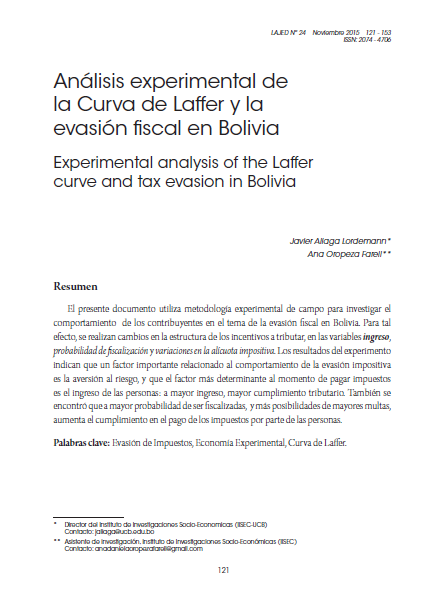Experimental analysis of the Laffer curve and tax evasion in Bolivia
DOI:
https://doi.org/10.35319/lajed.20152472Keywords:
Tax Evasion, Experimental Economics, Laffer CurveAbstract
This document uses experimental field methodology to investigate the behavior of taxpayers on the issue of tax evasion. The aim of making changes in the structure of incentives, such as income, the probability of inspection and variations in the tax rate, is to evaluate the behavior of economic agents when these changes are made. The experiment results indicate that an important factor is the risk aversion in the adoption of tax evasion behavior and the determining factor when paying taxes is the income of individuals: the higher the income, the greater tax compliance. We also found that greater chances of being audited and higher fines, increases compliance in paying taxes.
Downloads
References
Alligham, M. G. y A. Sandmo (1972). “Income Tax Evasion: A fteoretical Analysis”, Journal of Public Economics, 1: 323-338, Philadelphia, U.S.A.
Barou, V. (2008). “L’economie experimentale: un nouvel outil pour les SES”. Idées, 153:48-56.
Bergman, M. y A. Nevarez (2005). “¿Evadir o pagar impuestos? Una aproximacion a los cumplimientos ”. Politica y Gobierno, XII(1): 9-40.
Bour, E. A. (2009). “Las retenciones, Laffer, Hurwcz y los incentivos al productor”. Indicadores de coyuntura, Nº 502.
Brandts, J. (2007). “La economia experimental y del comportamiento”. En: Filosofía y economía: una mirada metodológica. Enciclopedia Iberoamericana de Filosofía. Barcelona: Instituto de Análisis Económico (CISC).
Centro de Investigación Económica de las Antillas (Cenantillas) (abril 2003). La curva de Laffer.
Cowell, F. (2004). “Carrots and Sticks in Enforcement”. En: H. J. Aaron y J. Slemrod (eds.) The Crisis in Tax Administration. Brookings Institute Press, Washington, DC, pp. 230–257.
Cox, J. C. y W. Harrison, (2008). “Risk Aversion Experiments.” Research in Experimental Economics, vol. 12: 41-196.
Gonzáles, D. T. y Doria, M. E. (2009). La curva de Laffer y la optimizacion del recaudo tributario en Cartagena Colombia. Cartagena.
Gould, J. P. y P. L. Edward (2004). Teoría microeconómica. México: Fondo de Cultura Económica .
Guth, F., R. Schmittberger y B. Scwartz (1982). “An Experimental Analysis of Ultimatum Bargaing”. Journal of Economic Behavior and Organization, 3:367-388.
Harrison, G. y J. List (2004). “Field Experiments”. Journal of Economic Literature, XLII (diciembre): 1013-1059.
Harrison, G. y E. Ruststrom (2008). “Risk Aversion in the laboratory.” En: Cox y Harrison (2008).
Holt, C. A. y S. K. Laury (2002). “Risk aversion and incentive effects”. The American Economic Review, 92(5):1644-1655.
Jaldun, I. (2006 [1377]). Introducción a la historia universal (Al-Muqaddima). Fondo de Cultura Económica.
Laffer, A. (1981). “Government, Exactiones and Revenue Deficiences”. Cato Journal, 1(1): 1-21.
--------- (2004). The Laffer Curve: Past, Present, and Future. Disponible en: The Heritage Foundation: http://www.heritage.org/research/reports/2004/06/the-laffer-curve-past-present-and-future. Consultado: 15 de agosto de 2014.
Miller, R. L. y R. E. Meiners (1996). Microeconomía. McGraw-Hill.
Network, T. T. (2011). The cost of tax evasion abuse: A briefling paper on the cost of tax evasion world wild. Tax Justice Network.
Neumann, J. V. y O. Morgenstern (1944). Theory of Games and Economic Behavior. Princeton University Express.
Pardo, J. U. (2005). Economía experimental. Decisiones con incertidumbre, racionalidad y teoría de la expectativa. Madrid, España: Universidad San Pablo CEU, Facultad de Ciencias Económicas y Empresariales.
Policonomics. (2012). Risk and uncertainty II: Risk aversion. Disponible en: http://www.policonomics.com/lp-risk-and-uncertainty2-risk-aversion/. Consulta: marzo de 2015.
Servicio de Impuestos Internos (SIN) (2012). http://www.sii.cl/principales_procesos/fiscalizacion.htm. Consulta: 20 de diciembre de 2014.
--------- (2013). “El SIN logro un crecimiento sostenido de las recaudaciones, 23% mas que el 2012 y 377% mas que el 2005.”: Disponible en: http://www.impuestos.gob.bo/index.php?option=com_content&view=article&id=1205:el-sin-logr%C3%B3-un-crecimiento-sostenido-de-las-recaudaciones,-23-m%C3%A1s-que-en-2012-y-377-m%C3%A1s-que-en-2005&catid=100&Itemid=565. Consulta: noviembre de 2014.
---------- (2014). “El SIN recaudó Bs. 42,952.5 millones hasta octubre de 2014.” Consulta: 16 de noviembre de 2014.
Smith, A. (1794). An Inquiry Into the Nature and Causes of the Wealth of Nations. (Cannan ed).
Smith, V. (1994). “Economics in the laboratory”. Journal of Economic Perspectives, 8:113- 131.
Streb, J. M. (2010). "Historia del pensamiento económico". Universidad del CEMA (UCEMA), Buenos Aires, Argentina.
Ventocilla, J. E. (2011). “En busca de la Curva de Laffer para el caso peruano”. Horizonte económico, 1.
Wanniski, J. (1978). “Taxes, Revenues and the Laffer Curve”, The Wall Street Journal.
Yolis, L. (2013). La Curva de Laffer. DNI 31.624.646
Zenada, C. E. (2003). Control y fiscalización de los ingresos públicos. Perú: Contraloría General de la República del Perú






